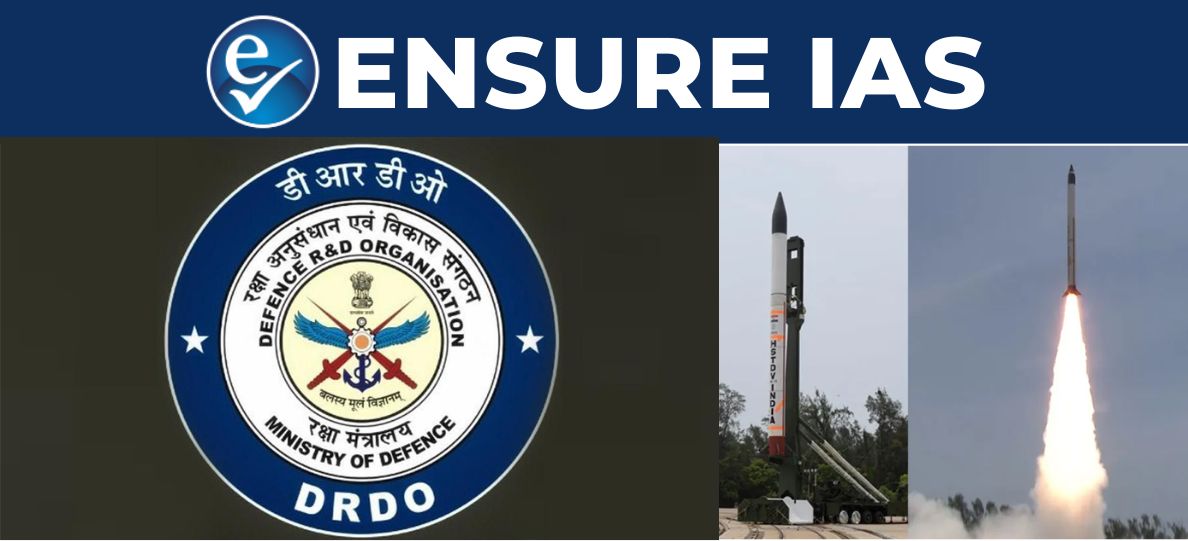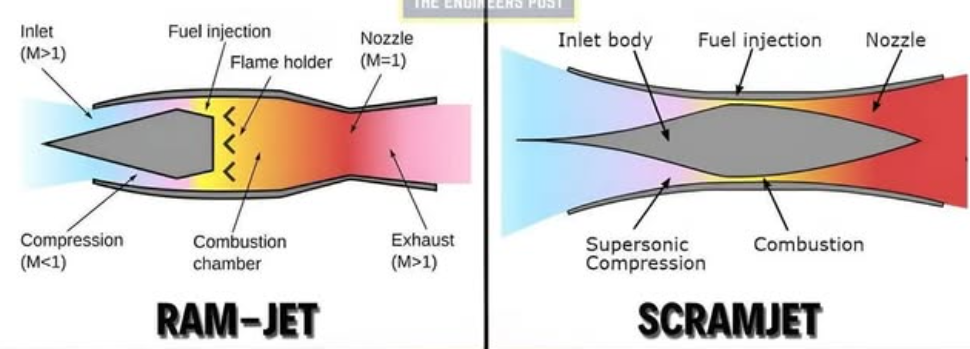- Courses
- GS Full Course 1 Year
- GS Full Course 2 Year
- GS Full Course 3 Year
- GS Full Course Till Selection
- Answer Alpha: Mains 2025 Mentorship
- MEP (Mains Enrichment Programme) Data, Facts
- Essay Target – 150+ Marks
- Online Program
- GS Recorded Course
- Polity
- Geography
- Economy
- Ancient, Medieval and Art & Culture AMAC
- Modern India, Post Independence & World History
- Environment
- Governance
- Science & Technology
- International Relations and Internal Security
- Disaster Management
- Ethics
- NCERT Current Affairs
- Indian Society and Social Issue
- NCERT- Science and Technology
- NCERT - Geography
- NCERT - Ancient History
- NCERT- World History
- NCERT Modern History
- CSAT
- 5 LAYERED ARJUNA Mentorship
- Public Administration Optional
- ABOUT US
- OUR TOPPERS
- TEST SERIES
- FREE STUDY MATERIAL
- VIDEOS
- CONTACT US
DRDO successfully conducts scramjet engine for hypersonic missiles
DRDO successfully conducts scramjet engine for hypersonic missiles

- In January 2025, The Defence Research and Development Organisation (DRDO) made a major progress by successfully testing a scramjet combustor for 120 seconds.
- This test showed India's development of hypersonic missiles.
- The Ministry of Defence (MoD) has called this test crucial in advancing next-generation hypersonic technology.
- Next-generation hypersonic technology refers to advanced technologies that enable the development of hypersonic vehicles capable of traveling at speeds greater than Mach 5 (5 times the speed of sound, or over 3,800 miles per hour/6,200 km/h)
What Are Hypersonic Missiles?
|
What are Scramjets and Ramjets Engine and How It Work:

- Ramjets are air-breathing engines that use the vehicle’s forward motion to compress incoming air for combustion.
- They work efficiently at supersonic speeds (around Mach 3) but lose efficiency at hypersonic speeds (above Mach 5).
- Scramjets (Supersonic Combustion Ramjets) are designed to operate at hypersonic speeds. Unlike ramjets, scramjets allow air to stay supersonic through the combustion chamber, enabling more efficient operation at higher speeds. This makes the design and operation of scramjets far more complex.
- Challenges: Designing and operating scramjets is much more complex, as air must flow through the engine without slowing down, which presents many engineering challenges.
DRDO’s 120-Second Scramjet Ground Test:
- The test, carried out by DRDO’s Defence Research and Development Laboratory (DRDL) in Hyderabad, successfully showed a scramjet combustor running for 120 seconds.
- This was the first time such a test has been conducted in India.
- The test showed that the scramjet combustor could sustain stable combustion at speeds of over 1.5 kilometers per second.
- The combustor also used a new flame stabilization technique that keeps the flame steady in the engine’s high-speed airflow.
Achievements and Innovations:
- Indigenous Fuel Development: The scramjet test used a specially developed endothermic fuel—a fuel that absorbs heat during combustion, improving the engine’s cooling and ignition processes.
- This fuel was created by DRDL (Defence Research and Development Laboratory) in partnership with industry partners.
- Thermal Barrier Coatings (TBC): DRDO also developed an advanced ceramic thermal barrier coating that can withstand the extreme temperatures generated during hypersonic flight.
- This coating is capable of surviving temperatures higher than the melting point of steel, crucial for protecting hypersonic vehicles.
The Journey of Hypersonic Technology in India:
India has been working on hypersonic technology for over two decades, with significant progress in both scramjet engines and hypersonic systems.
-
ISRO’s Contributions:
- In August 2016, the Indian Space Research Organisation (ISRO) conducted the first successful flight test of its scramjet engine as part of the Air Breathing Propulsion Project.
- On July 22, 2024, ISRO carried out another flight demonstration of Air Breathing Propulsion Technology, where scramjet engines were mounted symmetrically on a Rohini Sounding rocket.
- ISRO is now focused on its Hypersonic Air Breathing Vehicle (HAVA) project, which aims to develop hypersonic vehicles for future space missions.
- Also, ISRO plans to use scramjet technology in future rockets to carry heavier payloads (satellites), as scramjets don’t need to carry oxygen as oxidizers like traditional rockets.
Organization |
Indian Space Research Organisation (ISRO) |
|
Founded |
August 15, 1969, replacing INCOSPAR (Indian National Committee for Space Research) formed in 1962. |
|
Parent Department |
Part of the Department of Space (DOS), Government of India, since 1972. |
|
Founder |
Dr. Vikram Sarabhai |
|
Main Goals |
- Develop space technology for national needs. - Focus on communication, weather, and resource management. |
|
Key Achievements |
- Created satellite launch vehicles (PSLV, GSLV). - Launched missions for navigation, communication, and weather. |
|
Research Contributions |
Promotes science and education in remote sensing, astronomy, atmospheric science, and space science. |
|
Headquarters |
Bengaluru, India |
|
Key Centres |
- Vikram Sarabhai Space Centre (VSSC): Builds launch vehicles - U R Rao Satellite Centre (URSC): Designs satellites - Satish Dhawan Space Centre (SDSC): Launches satellites - Liquid Propulsion Systems Centre (LPSC): Develops liquid and cryogenic engines - Space Applications Centre (SAC): Makes sensors for communication and remote sensing - National Remote Sensing Centre (NRSC): Handles satellite data processing |
|
Chairman |
The Chairman of ISRO is also the Secretary of DOS and Chairman of the Space Commission, which makes space policies. |
-
DRDO’s Hypersonic Technology:
- DRDO started working on hypersonic engines in the early 2000s and made significant progress in September 2020, when it successfully tested the Hypersonic Technology Demonstration Vehicle (HSTDV), which utilized the scramjet engine.
- In December 2020, DRDO opened its Hypersonic Wind Tunnel (HWT) facility in Hyderabad, which can simulate speeds between Mach 5 and Mach 12—one of the largest of its kind globally.
- February 2024 saw the successful testing of India’s first Hypervelocity Expansion Tunnel Test Facility by IIT Kanpur.
- This achievement places India among the few nations capable of advanced hypersonic testing.
Organization |
DRDO (Defence Research and Development Organisation) |
|
Parent Ministry |
Ministry of Defence, Government of India |
|
Vision |
Empower India with advanced defence technologies and achieve self-reliance in critical defence systems. |
|
Mission |
Equip the armed forces with modern weapon systems based on the needs of the three services. |
|
Key Achievements |
- Missiles: Agni & Prithvi series - Light Combat Aircraft: Tejas - Multi-barrel rocket launcher: Pinaka - Air defence system: Akash - Radars and electronic warfare systems |
|
Motto |
"Balasya Mulam Vigyanam" (The source of strength is science, which drives the nation in peace and war) |
|
Formation |
Established in 1958 from the merger of Technical Development Establishment (TDEs) and Defence Science Organisation (DSO). |
|
Growth |
Started with 10 laboratories, now expanded to 41 laboratories and 5 Young Scientist Laboratories (DYSLs). |
|
Research Areas |
- Aeronautics, Armaments, Electronics, Combat vehicles, Engineering systems, Instrumentation, Missiles - Naval systems, Life sciences, Information systems, Agriculture |
|
Major Projects |
- Development of missiles, aircraft, radars, electronic warfare systems, and other critical technologies. - Ongoing projects for defence systems and technology advancements. |
DRDO’s Future Projects in Hypersonics:
DRDO continues to work on several key areas of hypersonic technology, including:
- Aero-acoustic studies for quieter hypersonic vehicles.
- Frequency Selective Surfaces (FSS) using artificial intelligence to improve stealth and performance.
- Reaction Control Systems (RCS) for better control of hypersonic glide vehicles.
- Development of high-temperature fuels and advanced thermal coatings to withstand the extreme conditions of hypersonic flight.
Global Arms Race of Hypersonic Weapons:
Countries like the USA, Russia, China, and India are all developing hypersonic weapons.
- China conducted a successful test of a nuclear-capable hypersonic glide vehicle in August 2021, which reportedly circled the globe before striking its target.
- This test surprised US intelligence and highlighted China's growing capabilities.
- The US first tested scramjet engines in 2002, and Russia and China followed with their own tests.
- The rapid development of these technologies globally is due to their ability to counter missile defense systems and strike high-value targets with minimal detection.
|
Also Read |
|
UPSC Foundation Course |
UPSC Daily Current Affairs |
UPSC Monthly Mgazine |
CSAT Foundation Course |
Free MCQs for UPSC Prelims |
UPSC Test Series |
ENSURE IAS NOTES |
Our Booklist |




